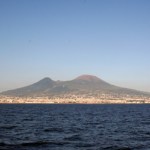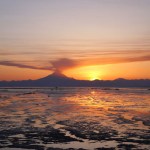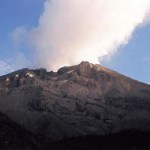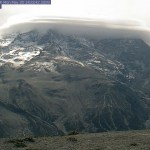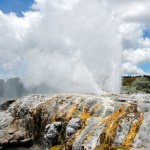
Now that we've had three Volcano Profiles: Rabaul, Hood and Vesuvius, now it is time to vote on the next volcano. Take your pick and leave comments!
What volcano should be featured as the next "Volcano Profile"?(polling)
The latest in my Volcano Profiles Series, we turn to Europe and Vesuvius. You could fill many, many volumes with the works produced on Vesuvius since Roman times. This profile will barely scratch the surface when it comes to the vast geologic and human history surrounding the volcano, but it is a start. If you want to learn more about the archaeology surrounding Vesuvius, try visiting Blogging Pompeii.
VOLCANO PROFILE: MT. VESUVIUS
Mt. Vesuvius in Italy. Image courtesy of Dario Leone.
Location: Italy
Height: 1,281 m / 4,203 ft
Geophysical location: The tectonics in the Mediterranean are very…
One brief note before I head out the door ...
Fissures formed in western Saudi Arabia during the earthquake swarm near Harrat Lunayyir during May and June 2009. Image courtesy of Ahmed Al-Hussaini.
The earthquakes in the Harrat Lunayyir region of western Saudi Arabia seem to be like a character out of Monty Python and the Holy Grail: they're just not dead yet. Two more earthquakes, these in the M3 range at 8-9 km depth, hit Thursday morning, further delaying the return of evacuees to the Al-Ais region. This bring the total earthquakes to over 150 since seismicity began a few weeks ago.…
Post any new volcano news you find here! I'll be back on June 15.
Ol Doinyo Lengai in Tanzania. Image courtesy of Peter Elliston, taken in 2006.
This will likely be my last new post for the next week or so. I'll be off to my home town for a wedding and a reunion. If you're jonesing for up to date volcano info, be sure to visit the Volcanism Blog or the European Volcanological Society news page. Feel free to post any other links you know or breaking volcano news over on the open thread as well! I will be posting a couple pieces over this next week, including the next volcano profile, so stay tuned for those as well. Regular posting of new volcano news should return June 15.
Mt. Redoubt in Alaska steaming in spring 2009. Image courtesy…
We've already talked about how many active volcanoes reside in Indonesia, but this week's USGS/SI update just drives that point home. Listed in the update are no less than 5 volcanoes were activity is being seen or is on the increase (Karangetang, Slamet, Dukono, Batu Tara and Makian). This doesn't mean mention the activity at Anak Krakatau, Rinjani or Semeru. Amazing.
Anyway, highlights - not counting Indonesia or the South American trio - from this week's report (as usual aptly put together by Sally Kuhn Sennert) include:
A ~8,000 foot / 2.4 km ash and steam plume from Bagana in Papua New…
This week's edition of Wednesday Whatzits could have been called "Miércoles Materia" as all the updates are for South American volcano. Enjoy!
Tungurahua in Ecuador
(Note: all links in spanish)
INGEOMINAS in Colombia is reporting that Nevado del Huila experienced 343 earthquakes over the past week, suggesting that something is brewing at the volcano. This has been accompanied by gas emissions and ash from the fractured dome. The Volcano Observatory in Popayán mentions that more than half of the earthquakes are related to magma moving into the system. Huila remains at Level III (Yellow)…
Turrialba volcano in Costa Rica.
Turrialba, one of Costa Rica's active volcanoes, is apparently showing signs of life according to a brief report by Teletica 7 (in spanish). There is increased seismic activity and elevated gas emissions at the volcano that last erupted in 2007* and 1866 prior to that. The fumarolic activity at the summit crater is not a new occurrence, however the report implies that it has gotten more intense as the volcano has experienced increasing seismicity since early May. The Volcanism Blog does have an excellent summary of the rumblings at Turrialba since earlier in…
Fissures formed by seismicity in the Al-Ais region of Saudi Arabia. Image courtesy of Ahmed Al-Hussaini.
Although it seemed last week that the earthquakes in western Saudi Arabia were subsiding last week, there have been a number of reports that there was still significant seismicity in the area over the weekend. Earthquakes in the M2.5-3.5 range occurred on Saturday - both of which the SGS are attributing to "subterranean volcanic activity." This has prevented the evacuees from the Al-Ais region to return to their homes. The Saudi government has begun to assess how much effect this activity…
Karangetang in Indonesia erupting during the mid 1990s. Image courtesy of VolcanoWorld.
The alert level at Karangetang, one of the most active volcanoes in Indonesia, was raised to Orange over the weekend and people living near the volcano have been evacuated. The volcano is apparently already producing ash and lava flows, but it is mostly the ash hazard that is prompting the evacuations. Karangetang erupts almost every year and sometimes with deadly consequences, as in 1992 when 6 settlers near the volcano perished.
Redoubt steaming away on May 4, 2009. Image courtesy of AVO/USGS
Fairly quiet weekend (except for the start of the College World Series regionals ... I do have a favored team*), volcanically speaking, but the ever-vigilant folks up in Alaska are keeping an eye on Redoubt as the eruption of 2009 continues.
The weekly status (released 5/29) for Redoubt released by AVO has no big surprises, reporting that "small discrete earthquakes and rockfall signals in the summit region have been recorded steadily over the course of the past week. In other words, the dome continues to extrude and part of it…
Here's some news bits for all you volcanophiles. Enjoy the weekend!
Ubinas in Peru steaming away in June 2007. Image courtesy of Eruptions reader Mike Lyvers.
There has been a lot of press lately on the theory that a large eruption from an ancient volcanic field in China (the 260-million-year-old Emeishan volcanic province of southwest China) could be the culprit in the grand Permian extinction. I have to admit, I've only skimmed the surface of this study, but the work lead by Dr. Paul Wignall (a paleontologist, not a volcanologist - not that there is anything wrong with that) seems to…
Your weekly dose of volcanic activity from the USGS/SI. (a little late thanks to an exciting day of column chemistry).
Some highlights include:
A 3.7 km / 12,000 foot ash plume from Karangetang in Indonesia (great name, eh?)
Lava flows, ash plumes and local ash falls from Slamet in Indonesia.
White and grey ash plumes rises to ~4 km / 13,000 feet from Colima, Mexico.
Blocks up to 2-m across were transported by lahars from Fuego in Guatemala. The volcano also produced ~4.6 km / 14,500 foot ash plumes.
Small ash plume spotted at Barren Island in the Andaman Islands of India.
You'll have to excuse the curtness of this post. An bad hop in softball will do that to you.
Here's some news:Mt. Dempo in Indonesia
Xinhua offers some nice pictures of the current activity going on at the summit crater at Nyiragongo in the Congo. Note the partially-crusted-over lava lake in the first shot. The Red Cross is updating the evacuation and mitigation plans for the area as the volcano shows increased activity.
The alert level at Mt. Dempo in Indonesia was raised to the second highest level. There has been ash fall (as far as 10 km from the vent) and volcanic gas emissions. The…
Lenticular clouds forming over Redoubt on May 25, 2009. Image courtesy of AVO/USGS and sent to me by Eruptions reader Todd Russell.
We haven't talked much about Redoubt lately, so I thought I'd add a brief update. First off, the Alert Level at the volcano still sits at Orange/Watch status, meaning that although the volcano is not erupting, it could at almost any time.
Most of the threat of eruption stems from the ever-growing lava dome on the volcano. AVO noted today that the "Hut webcam views today show evidence of recent rockfall activity, including a fresh ash deposit to the east (left)…
Al-Qider volcano in western Saudi Arabia. Image courtesy of Ahmed Al-Hussaini.
After a week's worth of worry, it appears that the seismicity in western Saudi Arabia is subsiding. The latest statement from Zuhair Nawab, the head of the SGS, is that over the past four days with fewer and less severe aftershocks. If this continues, people who have evacuated the area around Al Ais might be able to return to their homes in a few days. However, it is important to note that even though officials suggest the seismicity is waning (and there may be indications this is not entirely accurate), the swarm…
Pohutu Geyser in Rotorua, New Zealand. Image taken by Erik Klemetti in January 2009.
It has been busy busy week for me, capped off today with a talk about my field work in New Zealand (see above), so I don't have much to say. Not much new news today about the Saudi Arabian earthquake swarms, but again, I'll keep my eyes pealed (incidentally, I still haven't been able to figure out why no western news sources have even mentioned the swarm).
Anyway, here's are some volcanic tidbits to enjoy over the long weekend:
Vog, as seen from space. Volcanic fog, fashionably shortened to "vog" is a real…
UPDATE 5/21/2009 4:30 PM Pacific: The latest news suggests that there are little to no evidence of volcanic gases since Wednesday according to the SGS, but they continue to monitor.
Lava flows from a 1256 A.D. eruption near Medinah in Saudi Arabia (to the south of Harrat Lunayyir) taken by the crew of the ISS in 2004. It shows nicely the volcanic heritage (dark lava flow on right of image) in western Saudi Arabia. Image courtesy of JSC Earth Observation Lab.
Well, as the days go by, there are more and more indications that an eruption is about to occur in the Harrat Lunayyir region of Saudi…
A week's worth of volcano news in one sitting, thanks to the USGS and Smithsonian Inst.'s Global Volcanism Program.
Thanks again, Sally Kuhn Sennert for putting it together!
This week's highlights include:
Small ash column spotted at Manam, Papua New Guinea. We talked about Manam not too long ago.
More details of the ongoing submarine eruption at West Mata in the Mariana Islands.
The lava dome continues to grow on Redoubt, Alaska with no real collapse yet.
Pilots spotted small (2.1 km / 7,000 foot) steam/ash plumes at Suwanosejima, Japan.
5-6 km / 18-25,000 foot ash plumes were produced by…
I have finally gotten together enough to create a Google Earth image (below) of the location of the Saudi Arabian earthquakes and their depths/magnitudes. I only have the data from the USGS earthquake list, but it is very illuminating:
Harrat Lunayyir volcano in western Saudi Arabia from Google Earth with the current earthquakes shown on the image. Image courtesy of Google, earthquake data from the USGS. Click here to see a larger version.
The earthquakes look like this (all times are Universal Time):Date Time Mag. Depth
5/17 19:50 M4.6 10 km
5/19 06:38 M4.9 10 km
5/19 16:54 M4.9 10 km
5/19…
